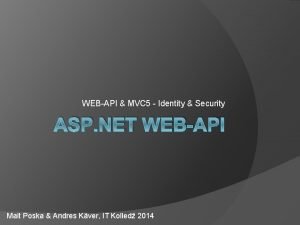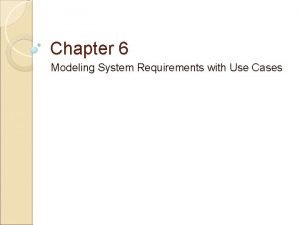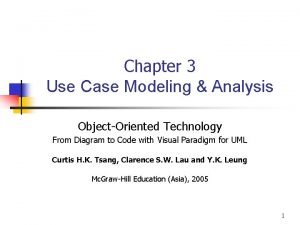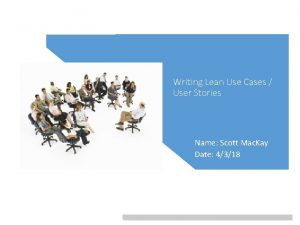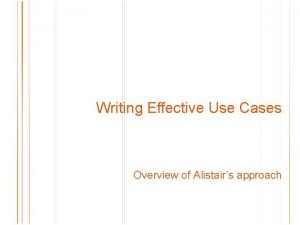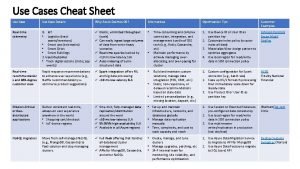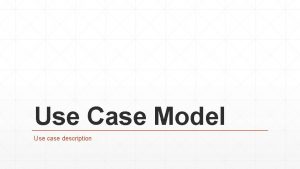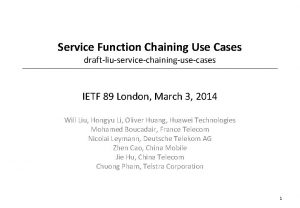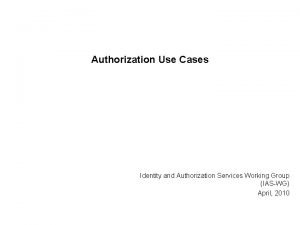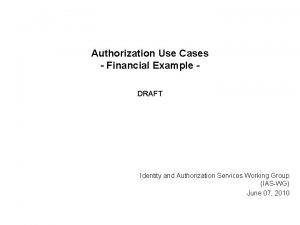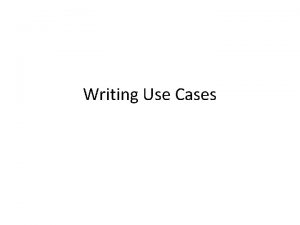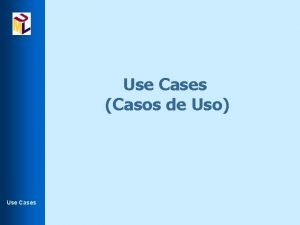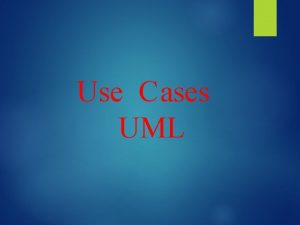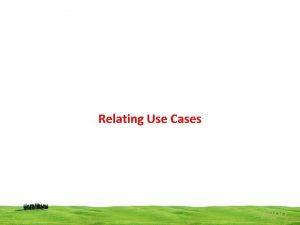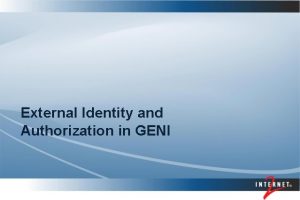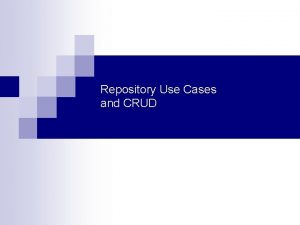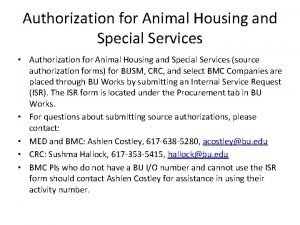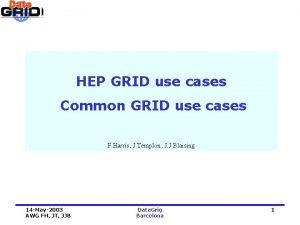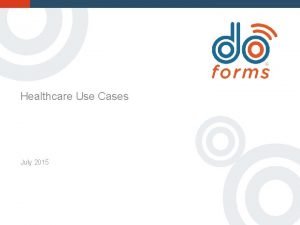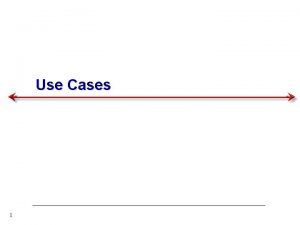Authorization Use Cases Identity and Authorization Services Working
















- Slides: 16

Authorization Use Cases Identity and Authorization Services Working Group (IAS-WG) April, 2010

Auth. Z Use Case - Web SSO via Web Access Management (WAM) System Principal PEP User/device WAM plug-in Environment Target Resource HTML or web app Time/Location PDP WAM Server PIP LDAP PAP WAM console

Use case details – Web SSO via Web Access Management (WAM) System Author: John Tolbert Brief Description: Human user requesting access to an html document protected by a web access management system (WAM). Policy information stored in LDAP, authored within WAM. Goal: Human user gains access to authorized document or application. Actors: User, PEP, PDP, PIP, PAP, resource. Initial conditions: User clicks link to protected resource Steps or flow: User clicks link to protected html resource; WAM plug-in on host system asks PDP if the user can get access; PDP relies on pre-authored LDAP policy data; PDP returns result to PEP, host system delivers document to user. Post-conditions: Transaction logged. Non-functional requirements: Business rules: Optional rules to consider include regulations (export, HIPAA, SOx), privacy, intellectual property controls, national security, need-to-know, etc. Issues: PEP and PDP deployments in this case are limited to platforms served by the WAM agent and server.

Auth. Z Use Case - Web SSO via SAML Principal User/device PEP SAML-enabled Web app Environment Target Resource HTML or web app Time/Location PDP SAML server PIP LDAP PAP LDAP & SAML consoles

Use case details – Web SSO via SAML Author: John Tolbert Brief Description: Human user requesting access to an html document protected by a web application that accepts SAML assertions. Policy information stored in LDAP, authored within LDAP/SAML/other utilities. Goal: Human user gains access to authorized document or application. Actors: User, PEP, PDP, PIP, PAP, resource. Initial conditions: User clicks link to protected resource Steps or flow: User clicks link to protected html resource; SAML assertion with appropriate attributes created and passed to application; application on host system asks PDP if the user can get access; PDP relies on pre-authored LDAP policy data; PDP returns result to PEP, host system delivers document to user. Post-conditions: Transaction logged. Non-functional requirements: Business rules: Optional rules to consider include regulations (export, HIPAA, SOx), privacy, intellectual property controls, national security, need-to-know, etc. Issues: PEP and PDP deployments in this case are limited to platforms served by the SAML-enabled application.

Auth. Z Use Case – File access mediated by operating system (OS) Principal PEP User/device OS Target Resource File Environment Time/Location PDP OS PIP OS PAP OS utilities

Use case details – File access mediated by operating system (OS) Author: John Tolbert Brief Description: Human user requesting access to a file controlled by an operating system (OS). Policy information stored within OS structures, authored by OS utilities. Goal: Human user gains access to authorized document or application. Actors: User, PEP, PDP, PIP, PAP, resource. Initial conditions: File created with permissions, access determined in advance by entitlement creation using OS utilities. Steps or flow: User attempts to access a file protected by an OS. OS makes decision based upon entitlements created by OS utilities. File delivered to user. Post-conditions: Transaction logged. Non-functional requirements: Business rules: Optional rules to consider include regulations (export, HIPAA, SOx), privacy, intellectual property controls, national security, need-to-know, etc. Issues: PEP and PDP deployments in this case are dependent on the OS and its mechanisms.

Auth. Z Use Case – remote network access to virtual private network (VPN) Principal PEP User/device VPN Target Resource Network Environment Time/Location PDP RADIUS PIP RADIUS DB PAP RADIUS utilities

Use case details – remote network access to virtual private network (VPN) Author: John Tolbert Brief Description: Human user and/or requesting access to a network controlled by a VPN device. Policy information stored within RADIUS (or TACACS or LDAP), authored by RADIUS utilities. Goal: Human user gains access to authorized network. Actors: User, PEP, PDP, PIP, PAP, resource. Initial conditions: Entitlements created in advance by RADIUS utilities. VPN client software installed. Steps or flow: User attempts to access a remote network. VPN device makes decision based upon entitlements created. Network access granted to user. Post-conditions: Transaction logged. Non-functional requirements: Business rules: Optional rules to consider include regulations (export, HIPAA, SOx), privacy, intellectual property controls, national security, need-to-know, citizenship, etc. Issues: PEP and PDP deployments in this case are dependent on the OS and its mechanisms.

Auth. Z Use Case – Database access using local DB accounts Principal PEP User/device DB Environment Target Resource Rows, columns, or tables Time/Location PDP DB PIP DB security tables PAP DB utilities

Use case details – Database access using local DB accounts Author: John Tolbert Brief Description: Human user requesting access to data stored in a database. Policy information stored in internal database security structures (user, group, permissions tables), created by DB utilities. Goal: Human user gains access to authorized document or application. Actors: User, PEP, PDP, PIP, PAP, resource. Initial conditions: User executes SQL query against database. Steps or flow: User executes SQL query against database. Database security functions match user context information against pre-configured values in the user, group, and permissions table structures within the database itself. If conditions are met, results will be returned. Post-conditions: Transaction logged. Non-functional requirements: Business rules: Optional rules to consider include regulations (export, HIPAA, SOx), privacy, intellectual property controls, national security, need-to-know, etc. Issues: PEP and PDP deployments in this case are limited to platforms which can operate within the database program.

Auth. Z Use Case – Database access via web application Principal Web app/ Service account PEP DB Environment Target Resource Rows, columns, or tables Time/Location PDP DB PIP DB security tables PAP DB utilities

Use case details – Database access using Database access via web application Author: John Tolbert Brief Description: Human user requesting access to data stored in a database via a web application. Policy information stored in internal database security structures (user, group, permissions tables), created by DB utilities. Goal: Human user gains access to authorized document or application. Actors: User, PEP, PDP, PIP, PAP, resource. Initial conditions: User clicks link in web application that launches a SQL query against a back-end database. Steps or flow: User clicks link in web application that launches a SQL query against a backend database. Web application executes SQL query on behalf of the user, either using impersonation or a service account. Database security functions match user or service account context information against pre-configured values in the user, group, and permissions table structures within the database itself. If conditions are met, results will be returned. Post-conditions: Transaction logged. Non-functional requirements: Business rules: Optional rules to consider include regulations (export, HIPAA, SOx), privacy, intellectual property controls, national security, need-to-know, etc. Issues: PEP and PDP deployments in this case are limited to platforms which can operate within the database program. WAM may also front-end the web application.

Auth. Z Use Case: Multi-channel access to financial service Typical self-serve channels include online, ABM, IVR, Mobile Principal Involved party/channel PEP Channel Credential Collector Environment Channel type, Location Target Resource Financial web Application or service PDP Auth. Z Web Service PIP PAP LDAP Policy Store Admin point

Use case details: Multi-channel access to financial service Author: Gavin Illingworth Brief Description: Involved Party (IP) is a subject who may play a role of (bank) customer, guarantor, trustee or similar. IP uses bank-issued credentials to first authenticate to a channel. IP is then authorized to access one or more services. Which services are permitted depends on the following factors: Goal: Managed access to financial applications Actors: User, PEP, PDP, PIP, PAP, resource. Initial conditions: Subject has authenticated to a channel. Subject has been assigned several credentials of varying strength. Steps or flow: 1. 2. 3. 4. 5. 6. 7. 8. 9. Subject authenticates to channel Authentication Service gets channel properties, credential type and assurance level of identity The assurance level assigned to a subject at registration time (depends on bona fides, such as driver’s license, submitted by the subject at a branch). This is a static value A session assurance level is calculated as determined by the strength of the supplied credential and channel properties, such as channel type and location Uses authorization rules in the Policy Store to calculate decisions The session assurance value is used (in prior step) to assess what entitlements are ‘operational’ during the session. Returns authorization decision back to the invoking applications. The “conditional” return value may result in a request to the customer/user to provide additional credentials to increase the session assurance level (stronger credential). Subject may be granted resource access

Use case details: Multi-channel access to financial service (2) Business rules: Issues: The list of services during a session is not fixed, but is dynamically calculated as shown. The implication for the UI is that, although there is a list of (all) available services determined by entitlements (at enrolment time), the authorization decision during a session may render some of them non-permissible. Do you present both and remind the subject that additional Auth. N is required for any services greyed out in the session? Or do you present only the ones permissible for that Auth. Z decision?
 Criminal cases vs civil cases
Criminal cases vs civil cases Authentication filters in mvc 5
Authentication filters in mvc 5 Dmap web portal
Dmap web portal Hot working and cold working difference
Hot working and cold working difference Hot hot
Hot hot Machining operations
Machining operations Pembentukan logam
Pembentukan logam Use case priority matrix for system
Use case priority matrix for system Identifying actors and use cases using textual analysis
Identifying actors and use cases using textual analysis Smart work and hard work
Smart work and hard work Identity mapping activity
Identity mapping activity How to write use cases
How to write use cases Writing effective use cases by alistair cockburn
Writing effective use cases by alistair cockburn Cosmos db use cases
Cosmos db use cases Use case description contents includes?
Use case description contents includes? Couchbase full text search example
Couchbase full text search example Service chaining use cases
Service chaining use cases

